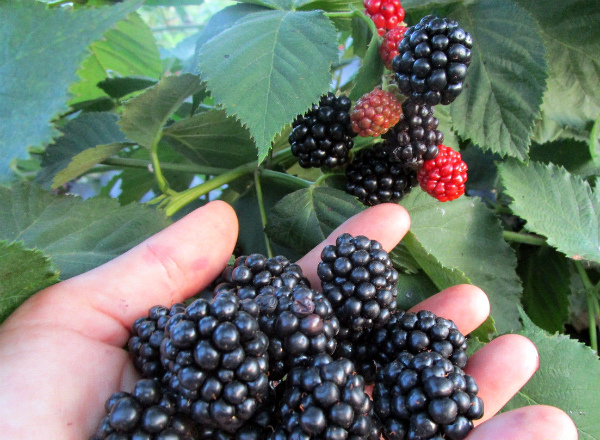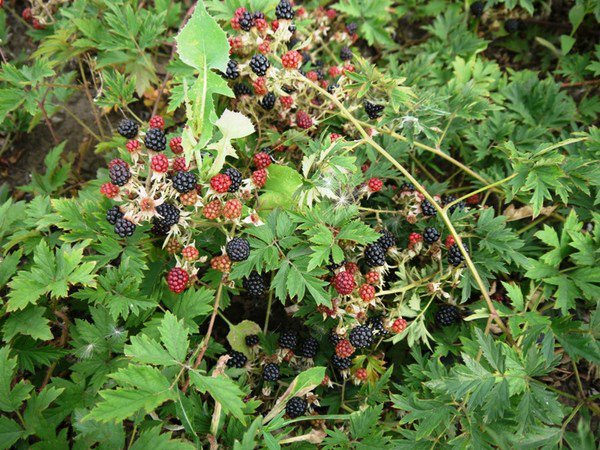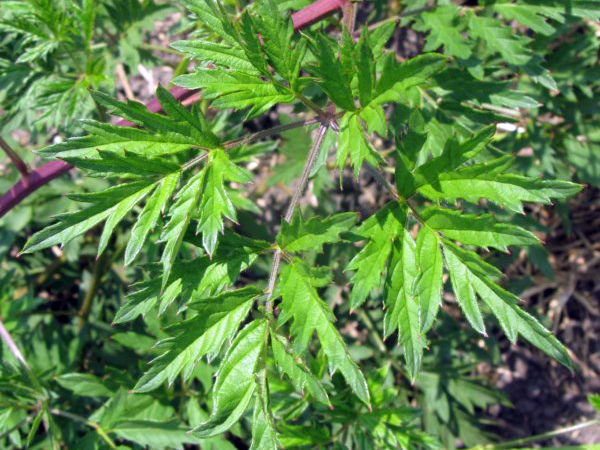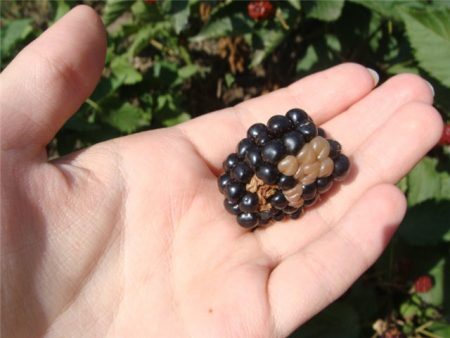Features of growing thornless blackberry thornless
Content
Description and characteristics of the variety
This blackberry variety is very similar to Thornfrey, but differs in larger berries - each reaches a weight of up to 15 g. Fruiting does not begin until August - it is during this period that the first berries ripen: very sweet, black and dense. The culture forms a powerful bush with upright shoots and dark green leaves. The variety is characterized by large white flowers, collected in lush inflorescences. The flowering period begins in June. Such blackberries are not particularly whimsical in the choice of soil: they can grow with any soil composition, but for best results, the bush must be fed.
Blackberries of the Thornless variety tolerate transportation well and retain their presentation for a long time.
Thornless combines several varieties of blackberries, which have a common feature - the absence of sharp thorns.
Blackberry Oregon Thornless is a thornless plant with creeping shoots reaching 4 meters in length. Fruits with excellent taste, but not very large. The variety is high yielding and highly decorative thanks to its attractive carved leaves. Blackberries with medium winter hardiness, require mandatory protection from winter frosts;
Hull Thornless is another unspiked blackberry that bears fruit with sweet berries. This hybrid variety was bred in the United States and is best suited for cultivation in those latitudes where the temperature does not drop below 6-8 degrees. The shoots of such plants can reach a length of 5 meters, and they themselves are quite powerful. The variety has a high yield.
Austin Thornless is a thornless, mid-season and unpretentious crop, with long, powerful shoots. Forms large fruits - an average of 8-9 grams. The berries are sweet, with a sour note. The variety is self-pollinated.
Completing today's review of the thornless blackberry cultivar Merton Thornless is a creeping plant with powerful faceted shoots without thorns. The culture is considered winter-hardy: it can tolerate frosts down to -30 degrees. The shrub is resistant to diseases, rarely affected by pests. Forms a large multiple cluster of ovaries - up to 50 medium-sized berries with a sweet and sour taste. Fruiting from early August to late September, allowing you to collect up to 10 kilograms of berries from each bush. The fruits are distinguished by excellent qualities - they do not crumple, do not lose their presentation for a long time.
Features of growing in garden plots
The main obstacle that Russian summer residents face in the process of growing blackberries is low temperatures in winter and lighting in the selected area.
But there is a way out: frost damaging the above-ground shoots of the culture will not be scary for it if you organize a decent shelter for the shrubs from the cold, dropping the shoots and fixing them on the soil surface. Another option is to completely trim the aboveground part of the bush. In this case, all shoots are removed, only the root system remains, which, according to gardeners, is not afraid of frost. But if you strive to get the maximum yield, you should not experiment, and still, organize a shelter.
The studless blackberry of the Oregon Thornless variety gives long and flexible whips, so it is most convenient to grow such a crop using special supports - trellises. As the shoots grow back, they are fan-shaped and fixed on supports. This method greatly facilitates not only the process of harvesting and caring for the plant, but also has a positive effect on the volume of fruiting: the branches do not shade each other, and the ovaries get the right amount of sunlight.
Landing technology
Thornless is best planted in a permanent open place in the spring, when warm weather has finally settled (a young seedling may not survive planting for the winter, even if it is properly covered).
It is necessary to prepare a plot for blackberries in the fall: apply organic fertilizers (humus or compost), dig up the soil to the depth of a shovel bayonet and leave it for the winter.
In the spring, holes of 50x50 cm are formed in the selected area, leaving a distance of about 1.5 m between them, and adhering to the row spacing of up to 2.5 m.The seedling must be carefully trimmed - shorten the lashes to 25 cm, removing all weak or damaged shoots. The planted plant is watered abundantly, at the rate of 1 bucket of water per bush and mulched.
Subtleties of care
The Thornless variety needs standard manipulations for plant care: blackberry beds need to be weeded regularly, getting rid of weeds (not only are weeds a habitat for many pests, they also take nutrients from the soil from the bushes), loosening the soil (to improve air access to the root system), water regularly and do not forget about regular feeding (it is enough to fertilize the bushes once a year, adding humus or compost).
With the arrival of autumn, blackberries need more care. The whips must be lowered from the support and carefully inspected. All damaged and fruiting branches must be completely removed, leaving only young shoots that have grown during this season for the winter. In this form, the plant is bent to the ground, fixed and covered with a protective cover until next spring.
Reproduction
Best of all, the Thornless blackberry, like any other, propagates by lateral root processes. But the trouble is that Thornless gives extremely few such shoots. Therefore, many gardeners got used to propagating this blackberry by dropping the tops of the shoots, fixing it on the ground so that the growing point is in close contact with the ground.
Diseases and pests
Surprisingly, for all its delicacy in matters of temperature, Thornless is rarely affected by diseases and pests. Sometimes on individual pods one can notice gray rot, which does not have a mass character (appears on the fruits of the lower branches that are in contact with the ground), and sometimes aphids may appear (to combat it, spray the bushes with infusion of tobacco dust (200 g), water (10 l ) and laundry soap (50 g).
Oregon Thornles Blackberry Planting Video
This video is about planting an Oregon Thornless blackberry in the fall, with an open root system.






